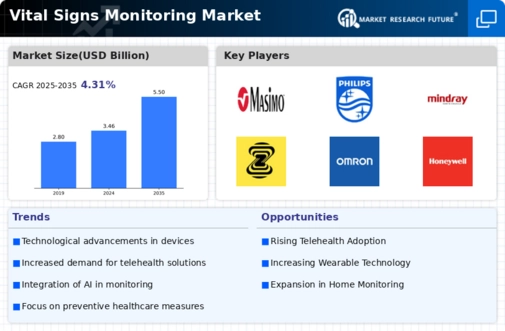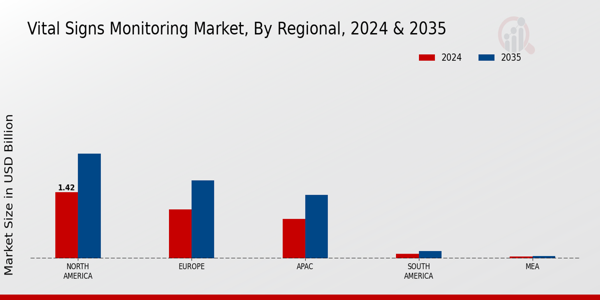Aging Population
The aging population is a critical driver of the Global Vital Signs Monitoring Market Industry. As individuals age, they often experience a decline in health, leading to an increased need for regular monitoring of vital signs. According to demographic studies, the proportion of older adults is expected to rise significantly in the coming years, leading to higher demand for healthcare services. This demographic shift is likely to result in a greater reliance on monitoring technologies to ensure timely interventions. Consequently, the market is anticipated to expand, with projections indicating a growth to 5.5 USD Billion by 2035.
Technological Advancements
The Global Vital Signs Monitoring Market Industry is experiencing rapid technological advancements, which enhance the accuracy and efficiency of monitoring devices. Innovations such as wearable sensors and remote monitoring systems are becoming increasingly prevalent. These technologies allow for continuous monitoring of vital signs, which is crucial for early detection of health issues. For instance, the integration of artificial intelligence in monitoring systems can analyze data in real-time, providing healthcare professionals with immediate insights. This trend is expected to contribute significantly to the market's growth, as the industry is projected to reach 3.46 USD Billion in 2024.
Increasing Health Awareness
Increasing health awareness among the global population is a notable driver of the Global Vital Signs Monitoring Market Industry. As individuals become more informed about the importance of regular health check-ups and monitoring, the demand for vital signs monitoring devices is likely to rise. Educational campaigns and public health initiatives are fostering a culture of proactive health management. This trend is particularly evident in developed regions, where consumers are more inclined to invest in personal health monitoring devices. The growing emphasis on preventive healthcare is expected to bolster market growth, aligning with the industry's expansion trajectory.
Government Initiatives and Funding
Government initiatives and funding play a pivotal role in shaping the Global Vital Signs Monitoring Market Industry. Various governments are investing in healthcare infrastructure and technology to improve patient outcomes. Initiatives aimed at enhancing telehealth services and remote patient monitoring are gaining traction, particularly in response to the need for efficient healthcare delivery. Such investments not only facilitate the adoption of vital signs monitoring technologies but also encourage innovation within the industry. As a result, the market is likely to benefit from increased funding and support, fostering an environment conducive to growth.
Market Trends and Growth Projections
Rising Prevalence of Chronic Diseases
The Global Vital Signs Monitoring Market Industry is significantly influenced by the rising prevalence of chronic diseases. Conditions such as diabetes, cardiovascular diseases, and respiratory disorders require continuous monitoring to manage effectively. The World Health Organization indicates that chronic diseases account for a substantial portion of global mortality, necessitating advanced monitoring solutions. This growing demand for effective management of chronic conditions is likely to drive the market forward. As healthcare systems increasingly adopt vital signs monitoring technologies, the market is projected to grow at a CAGR of 4.3% from 2025 to 2035.












Leave a Comment